Chapter 9: Cellular Respiration
1/54
There's no tags or description
Looks like no tags are added yet.
Name | Mastery | Learn | Test | Matching | Spaced |
|---|
No study sessions yet.
55 Terms
How are electrons transported?
Redox reaction
Involves hydrogen
How long does ATP last in the cell?
30 seconds
True or False: Cells obtain glucose to make ATP
True
True or False: Organisms store glucose as glycogen or starch
True
What happens when glucose is oxidized?
When glucose is oxidized to carbon dioxide by burning, some energy is released as heat and light
True or False: In cells, glucose is oxidized through a long series of carefully controlled redox reactions
True
During cellular respiration, _____ is _______, and ______ is reduced
1.) The fuel (such as glucose) is oxidized
2.) O2 is reduced
What is a source of high-energy electrons?
Organic molecules with an abundance of hydrogen
Cellular Respiration Equation

What happens when glucose is oxidized?
What is the purpose of fermentation?
To oxidize glucose and make ATP
Why is cellular respiration more effective than fermentation?
Cellular respiration produces more energy than fermentation does, because fermentation cannot fully oxidize glucose
What is the hub of energy processing in cells?
Glucose
What are the 4 steps of cellular respiration?
1. Glycolysis: A six-carbon glucose is broken down into two three-carbon pyruvate molecules
2. Pyruvate processing: Each pyruvate is oxidized to form acetyl-CoA
3. Citric acid cycle: Each acetyl-CoA is oxidized to CO2
4. Electron transport and oxidative phosphorylation: Electrons move through a transport chain - their energy is used to set up a proton gradient, which is used to make ATP
Where does glycolysis occur?
In the mitochondria
Phosphorylation
True or False: Cellular respiration oxidizes glucose to make ATP
True
What is cellular respiration?
Any set of reactions that uses electrons from high-energy molecules to make ATP
What is the process of cellular respiration?
Cellular respiration interacts with other pathways (catabolic pathways) that help to break down a variety of molecules. To produce ATP, cells first use carbohydrates, then fats, and finally proteins.
What is glycolysis?
A series of 10 chemical reactions that occur in the cytosol
Glucose oxidizes to create pyruvate - glucose is broken down little by little by removing electrons
Glycolysis Pathways
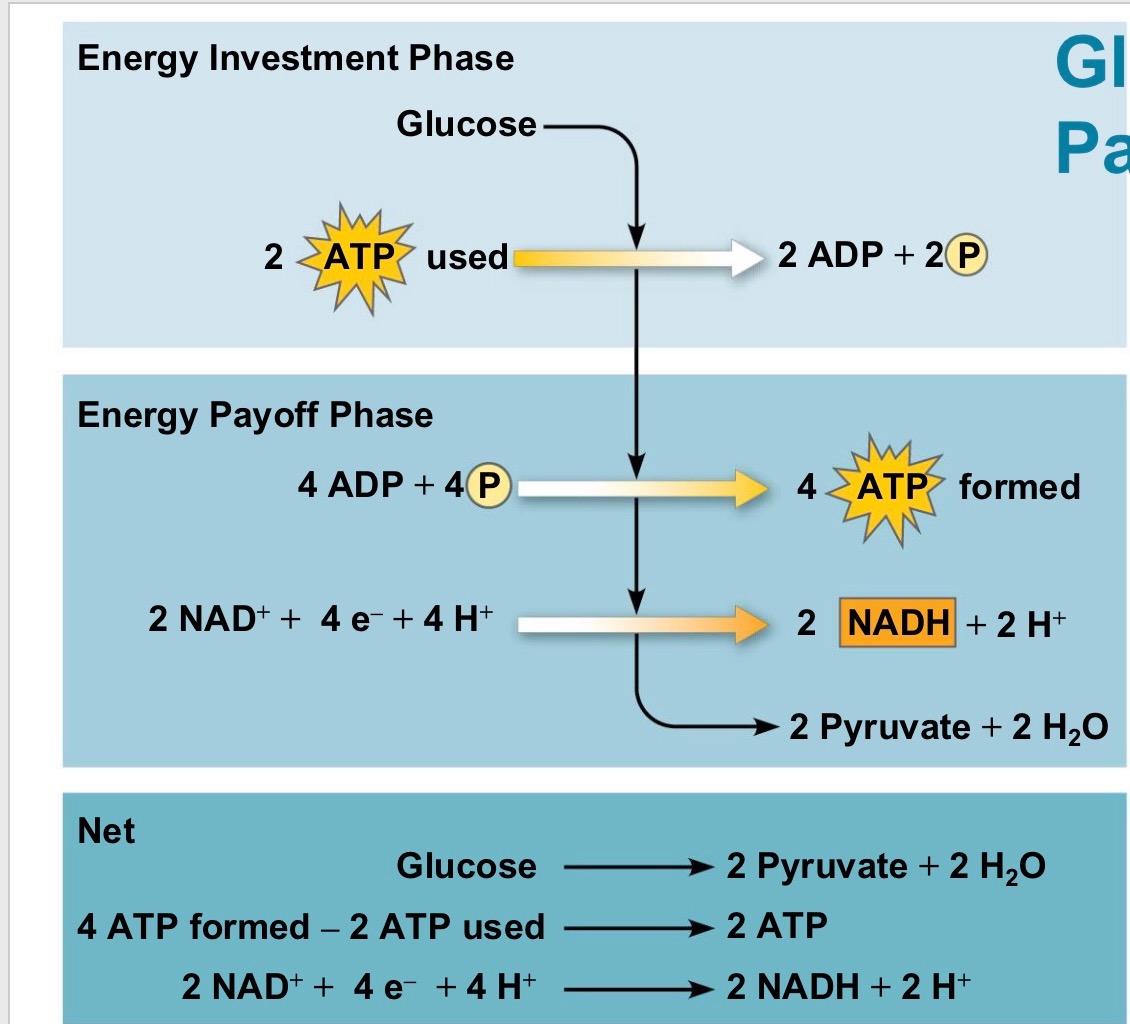
Glycolysis
A series of 10 chemical reactions that occur in the cytosol
ADPH
2 forms:
Oxidized (empty) form - NAD+ (no electrons)
NADH - Full, reduced form - picked up electrons
How is glycolysis regulated?
Feedback inhibition: High levels of ATP (product of glycolysis) inhibit the third enzyme: phosphofructokinase
What is the fuction of phosphofructokinase?
Enzyme that phosphorylates something
Prepares the glucose for further reactions by adding phosphogroups
Has 2 binding sites for ATP
When ATP levels are low, phosphofructokinase binds to the active site, and the enzyme catalyzes the third step in glycolysis
When ATP levels are high, it binds to a regulatory site and inhibits the enzyme, and the substrates can no longer bind properly to the active site
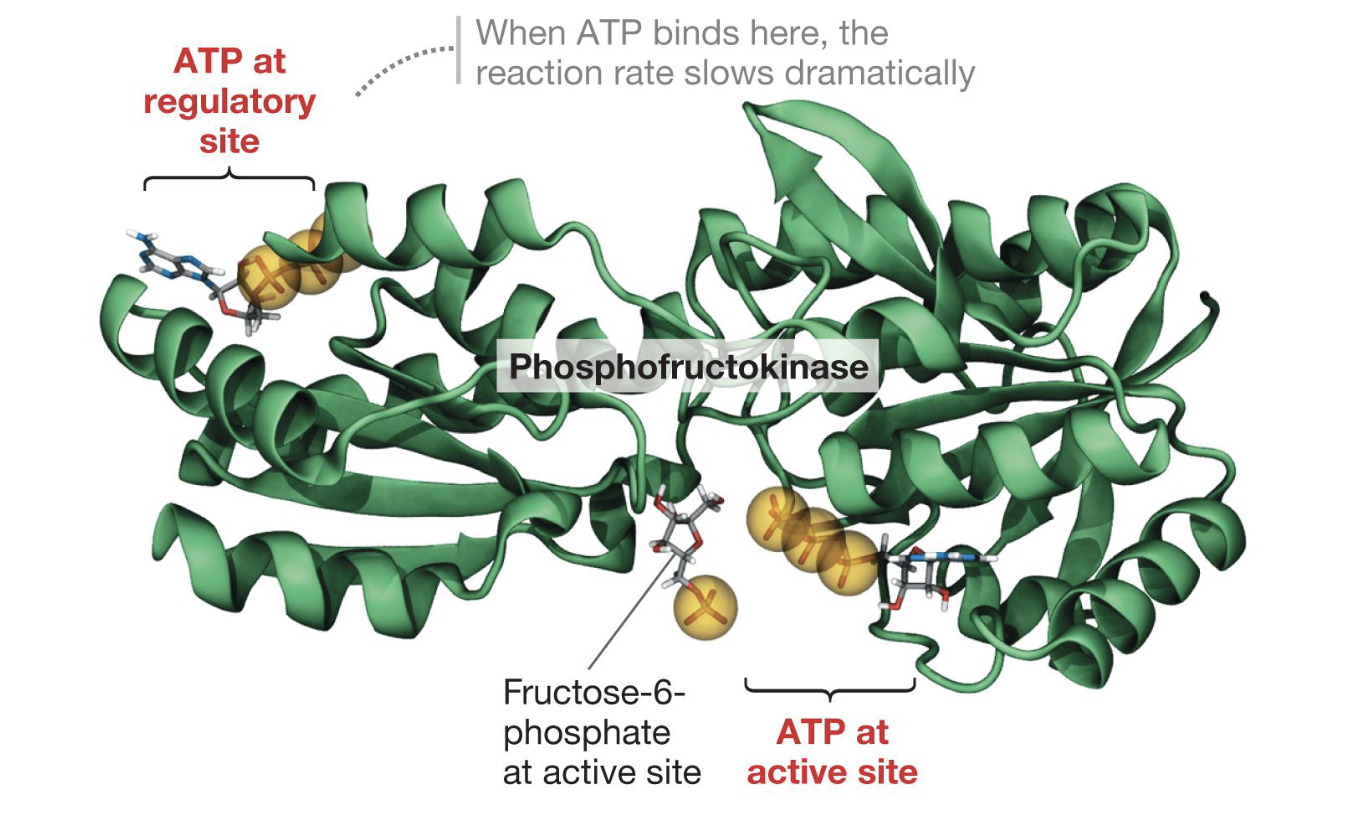
What are the three main steps in glycolysis?
1. Glycolysis starts by using two ATP in the energy investment phase (reactions 1–5)
2. During the energy payoff phase (reactions 6–10), NADH is made and ATP is produced by substrate-level phosphorylation
3. The net yield is 2 NADH, 2 ATP, and 2 pyruvate
True or False: A concentration gradient is needed to make ATP
True
True or False: Oxidation always goes with reduction
True
How is pyruvate is processed to Acetyl CoA?
• Eukaryotes: Pyruvate produced by glycolysis is transported into mitochondria
Pyruvate is processed by pyruvate dehydrogenase in the mitochondrial matrix in eukaryotes and cytosol in prokaryotes
• Pyruvate undergoes a series of reactions:
– One of its carbons is oxidized to CO2, and NADH is produced by reduction (redox)
– The remaining two-carbon unit is attached to coenzyme A, producing
acetyl CoA
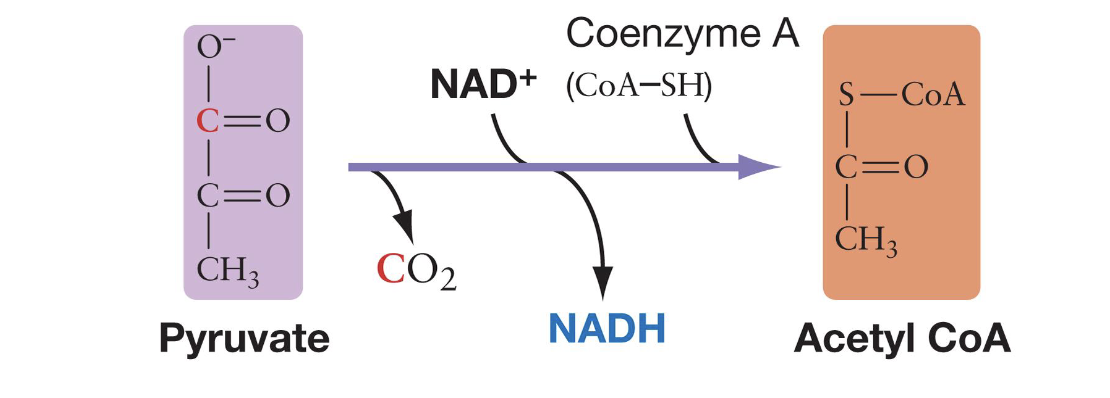
Cristae
Sack-like compartments formed by the inner membrane
Mitochondrial matrix
Located inside of the inner membrane
What gets oxidized in glycolysis?
Pyruvate
How is pyruvate regulated?
By feedback inhibition
Pyruvate dehydrogenase is shut down when it is phosphorylated
The rate of phosphorylation increases when levels of
NADH, acetyl-CoA, or ATP are high
• Pyruvate dehydrogenase is dephosphorylated at a higher rate when levels of ADP, pyruvate, CoA, or NAD+ are high
What happens during the citric acid cycle?
Each acetyl CoA from pyruvate
processing is oxidized into two CO2 molecules
• Located in the mitochondrial matrix (eukaryotes) and cytosol (prokaryotes)
• These reactions are organized in a cycle:
Starts by moving the acetyl group from acetyl-CoA to oxaloacetate to form citrate
Ends when oxaloacetate is regenerated
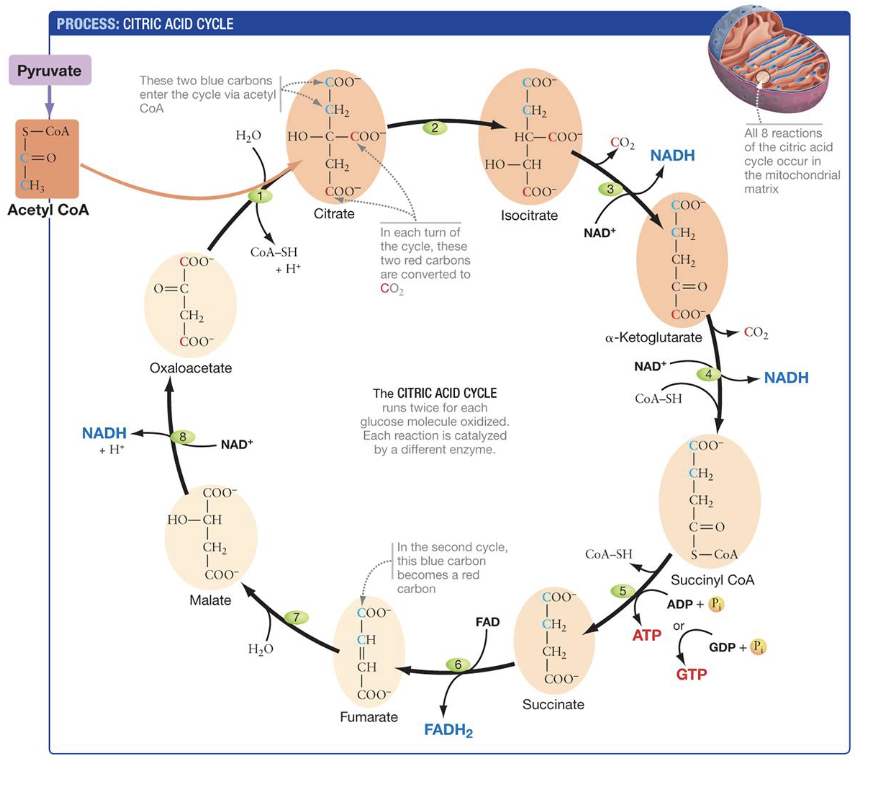
What is released in the citric acid cycle?
Potential energy
What are the functions of the released potential energy?
1. Reduce three NAD+ to NADH
2. Reduce one FAD to FADH2
3. Phosphorylate ADP (or GDP) to form ATP (or GTP)
• The cycle turns twice for each glucose molecule since 2 pyruvate are produced by glycolysis
True or False: Something must be reduced in order to become oxidized
True
What happens to NADH and FADH2?
• Most of glucose’s original energy is contained in the electrons transferred to NADH and FADH2
• Electrons (and protons) are ultimately transferred to oxygen to form water
For each molecule of glucose that is oxidized, the cell produces______,______,_______ and _________.
6 CO2/ 10 NADH/ 2 FADH2/ 4 ATP
True or False: Free energy changes as glucose is oxidized
True
What series of reactions occur in an electron transport chain (ETC)?
Reduction-oxidation reactions
Where do electron transport chain (ETC) reactions take place?
The inner membrane and cristae of the mitochondrion
What happens to the P.E of oxygen as it goes down the ETC?
Decreases and transforms into K.E
How does the ETC function?
• Energy from redox reactions is used to pump protons from the matrix into the intermembrane space
• Most of the chemical energy from glucose is now accounted for by a proton electrochemical gradient
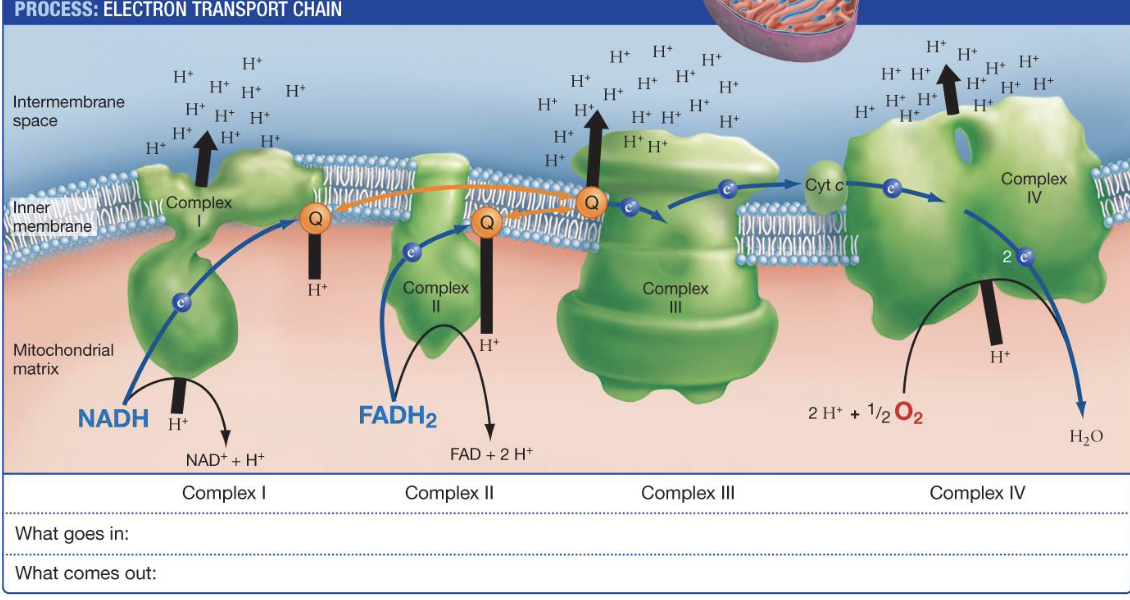
What is chemiosis and its process?
• ETC pumps protons from the matrix to the intermembrane space
• Proton gradient drives synthesis of ATP from ADP and Pi - a process called chemiosmosis
• ATP production is dependent on a proton motive force generated by the proton electrochemical gradient
ATP consists of what 2 components?
1. An ATPase “knob” (F1 unit)
2. A membrane-bound, proton-transporting base (F0 unit)
ATP synthase includes a___________, and an ___________.
Proton-Driven Rotor/ ATP-Generating Enzyme
Oxidative phosphorylation
29 ATP are produced from each molecule of glucose
How the majority of ATP is made during cellular respiration
What becomes the electron acceptor in fermentation?
Pyruvate
What is reduced during cellular respiration?
Pyruvate
What is the purpose of fermentation?
To stop the buildup of NADH by generating NAD+, which accepts the buildup of electrons
Pyruvate must accept electrons (no oxygen/ETC)
Prevents glycolysis, pyruvate processing, and the citric acid cycle from stopping
Food is preserved
What is NAD+ nessecary for?
Glycolysis
What is the purpose of glycolysis?
To produce ATP/ regenerate NAD+
How do you break bonds?
Via oxidization
Kelvin Cycle